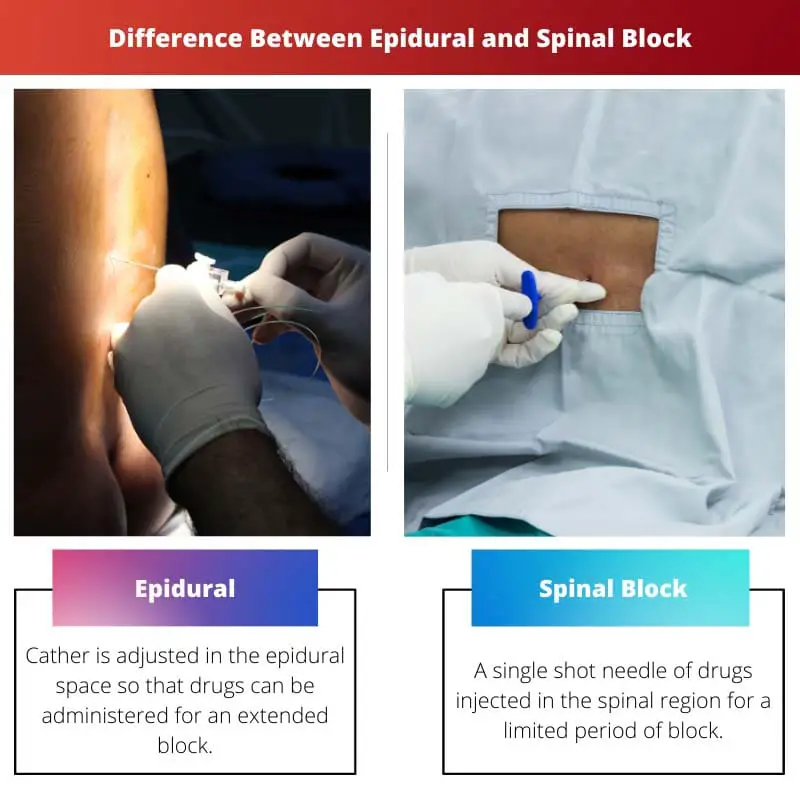Controlled loss of sensation, which is temporary, is used extensively in medical science to induce pain relief in surgeries and labor. The word anesthesia has been derived from its greek variant meaning ‘without sensation.’
Anesthetic drugs can be introduced into the system in multiple ways. Two standard methods of inducing blocks in the lower body are spinal block and epidural.
Both methods induce numbing in specific regions. Hence the patient is not completely sedated. Either way, the administration of anesthesia should be done under the supervision of a licensed medical professional.
Key Takeaways
- Epidurals are regional anesthesia techniques that inject medication into the epidural space near the spinal cord, providing continuous pain relief.
- Spinal blocks are a one-time anesthetic injection directly into the spinal fluid, offering rapid, short-term pain relief.
- Both methods are used for pain management during childbirth and surgery, with the choice depending on factors like the procedure, duration, and patient needs.
Epidural vs. Spinal Block
The difference between Epidural and Spinal Block is that epidural requires a catheter for carrying the anesthetic. In contrast, the spinal block can be given directly through a single injection in the cerebrospinal fluid. Hence in the case of Epidural, the block period can be extended.

Comparison Table
| Parameter of Comparison | Epidural | Spinal Block |
|---|---|---|
| Definition | Cather is adjusted in the epidural space so that drugs can be administered for an extended block | A single-shot needle of drugs is injected into the spinal region for a limited block period. |
| Needle Used | A more considerable need is used for administration. | A relatively smaller needle is used to introduce a spinal block. |
| Delivery Frequency | It can be delivered multiple times through a catheter | It can be given only once. |
| Site of Drug Injection | Drugs are injected in the epidural space. | Drugs are injected into the cerebrospinal fluid. |
| Local anesthetic | A large amount of local anesthetic is required. | A small amount of local anesthetic is required. |
| Principle | Drug moves along the tissue | Drug moves through the fluid. |
What is Epidural?
Epidurals are anesthetics used to induce blocks or pain relief. Epidural is administered via catheters.
A catheter is a small tube injected into the skin via a needle. Once the hand is removed, the line can be left to deliver medication and drugs.
As explained by some patients, an epidural induce period waves of a feeling of numbness. Epidurals are local anesthetics; hence the patient is conscious.
This is because the catheter for an epidural is placed outside the dura, in the epidural space. This means that drugs are allowed to move through tissue instead of fluid.
During the administration of an epidural, the dura might breach, causing what is popularly called an epidural puncture. Many local anesthetics are used to make the process easy and pain-free.
The anesthetics relieve the burning sensation; however, many patients feel the pressure of the needle pushing through. The hands used to administer an epidural are bigger.
It takes about 15v minutes for the epidural to work. A characteristic feature of an epidural is that it can be made to last too long, as the number of drugs entering the system can be adjusted.
The drug quantity is increased to extend the period of block. Epidurals are very commonly used to relieve labor pain in women.
The amount of the drug is adjusted according to the severity of the pain. It numbs the lower half of the body from the belly button to the lower legs.
Common side effects of epidurals are lower blood pressure and headache.

What is Spinal Block?
A spinal block is also known as an intradural block. It is a form of anesthetic that is given through the Cerebrospinal fluid.
It is administered via a single needle fine needle. Usually 9cm long. Syringes used for a spinal block are smaller.
A spinal block is used for numbing the lower end of the body for surgeries and other procedures. The needle punctures the dura, throwing the drugs inside the cerebrospinal fluid.
Since the movement of drugs is easier and faster via fluid, only small amounts of anesthetics are required. Spinal anesthetics are beneficial over complete sedation to avoid failed intubations. These are commonly used in orthopedic surgeries, hysterectomies, nephrectomies, etc.
They are also trendy for cesarean and vaginal deliveries. Another benefit of using spinal anesthesia during delivery is that the mother stays alert during the procedure.
Anatomically, a spinal block is used to inject the desired drug so that the transmission of nerve signals is blocked. Moderate sedation is occasionally given to help the patient relax during the procedure.
Surgeries can be done while the patient is wide awake. Spinal blocks are limited to surgeries below the abdomen because spinal blocks in the upper regions can interfere with a person’s ability to breathe.
It can cause conditions similar to lung paralysis. A prior medical analysis is essential before using a spinal block for numbing the body.
Conditions under which a spinal block might not be used include patients’ refusal, infection at the injection site, bleeding disorders, increased intracranial pressure, etc. Although spinal blocks are very commonly used and safe if administered by a licensed medical professional.
Minor complications include moderate hypotension, nausea, etc. Significant complications can be neural damage and death in sporadic cases.

Main Differences Between Epidural and Spinal Block
- The main difference between an Epidural and a spinal block is that an epidural involves the transfer of an anesthetic drug with a catheter. In contrast, a spinal block is given through a single injection.
- The size of the needle used in the case of an epidural is more significant than in the spinal block.
- The block period can be extended in the case of epidurals as the quantity of drug can be adjusted, while Spinal blocks involve a single injection. Hence block period is limited.
- The delivery site is the epidural space in the case of Epidurals, while cerebrospinal fluid is the target in spinal blocks.
- The amount of local anesthetic required is more for Epidurals, while spinal blocks require ver lessor no local or no anesthetic.

- https://onlinelibrary.wiley.com/doi/abs/10.1111/j.1399-6576.1988.tb02689.x
- https://europepmc.org/abstract/med/8198262

The description and comparison between epidural and spinal block are excellent, offering a good understanding of how the anesthesia works and the differences between them.
I agree, the article is well-written and presents complex information in a manner that’s easy to comprehend.
The article provides a clear and comprehensive breakdown of the differences between epidural and spinal block anesthesia methods. It’s a great read for anyone interested in medical science.
Absolutely, the piece offers valuable insights into the administration, usage, and implications of regional anesthesia techniques.
This excellent exposition on epidural and spinal block anesthesia is well-structured and informative. It’s a great piece for expanding one’s knowledge in this area.
Absolutely, the article is both informative and insightful. It provides a comprehensive understanding of the methods and implications of these anesthesia techniques.
I thoroughly enjoyed reading the article. The depth of information and clear presentation make it a beneficial resource for anyone studying this area of medical science.
I see a potential argument in favor of spinal blocks as they require smaller amounts of local anesthetic and are associated with faster and easier drug movement. It’s a valid point to consider the benefits over complete sedation.
While that might be true, there are specific cases where epidurals might be more beneficial. It’s crucial to analyze the patient’s needs and the nature of the procedure before deciding on the anesthesia method.
This article is extremely informative and well-detailed. It provides a comprehensive understanding of the differences between epidural and spinal block, as well as the methods of administration.
Absolutely, the article is a great educational resource for anyone seeking in-depth knowledge about regional anesthesia techniques.
This detailed overview of the procedures and the specifics of drug delivery for epidural and spinal block is commendable. It’s an excellent educational resource on this topic.
Absolutely, the article presents complex medical information in a way that’s interesting and accessible to a wide audience. Kudos to the author!
The detailed overview of epidural and spinal block, along with the key takeaways, helps in understanding the significance and implications of these anesthesia methods effectively.
Absolutely, the article is comprehensive and provides a well-rounded understanding of the topic.
The explanation of the drug delivery methods and the practical aspects of epidural and spinal block anesthesia is enlightening. A valuable resource for those interested.
I found the comparison table particularly helpful in understanding the nuances between epidural and spinal block. It’s an insightful article.
Absolutely, the key takeaways and the detailed description of the administration methods make it a valuable reference for understanding regional anesthesia techniques.
The article offers an insightful discussion around the applications and anatomical implications of both epidural and spinal block anesthesia. It’s a commendable piece of work.
I’m impressed with the article’s depth in explaining the administration process and the reasoning behind the use of different types of anesthesia for various medical procedures.
Agreed, both the informative content and the detailed comparison of the techniques make it a valuable resource for understanding regional anesthesia.
I find it fascinating how both methods work to provide pain relief in different ways. The comparison table clears up any doubt between epidural and spinal block.
Indeed, the details of the procedures and the differences in drug delivery mechanisms are very well-researched and explained in this article.